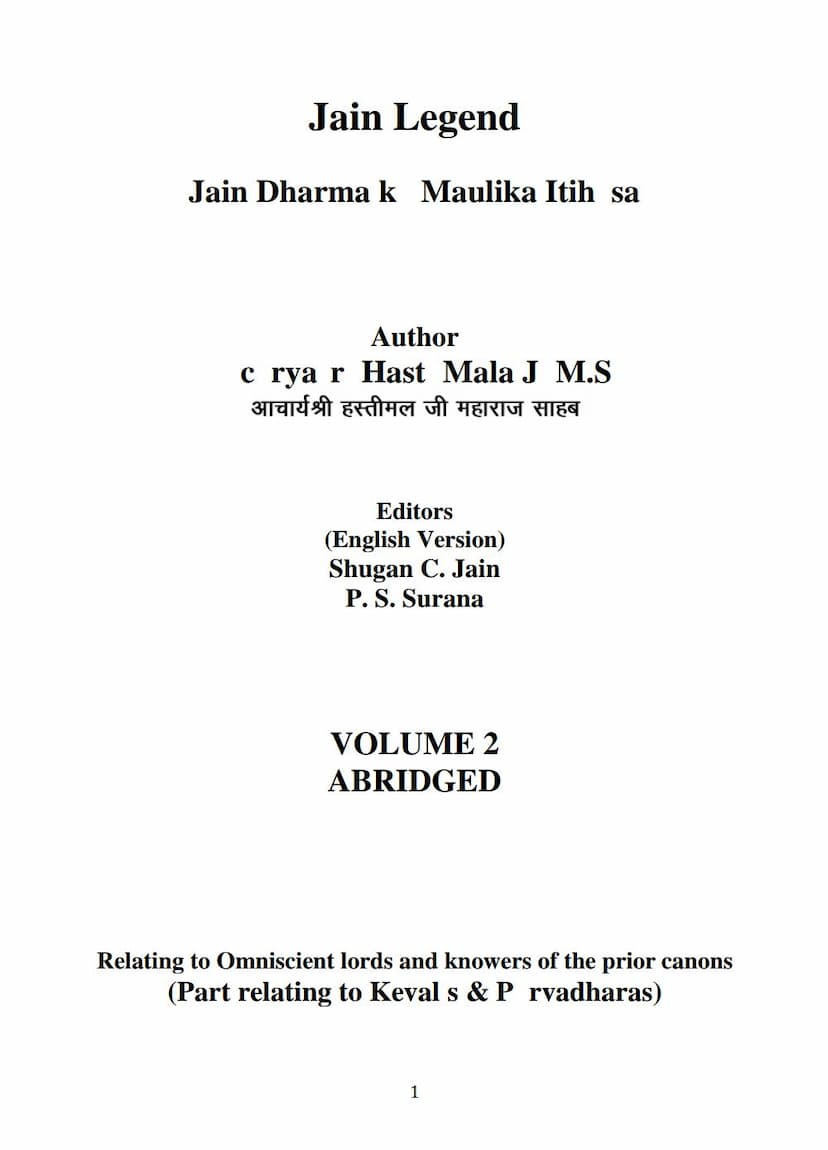Jain Legend Vol 2
Added to library: September 2, 2025

Summary
Here's a comprehensive summary of "Jain Legend Vol 2" based on the provided text:
Overview of "Jain Legend Vol 2"
"Jain Legend Vol 2" is the English translation of the abridged Hindi version of "Jain Dharma k Maulika Itih sa" (Original History of Jain Dharma). Authored by Acharya Shri Hastimal Ji Maharaj MS, a prominent Acharya of the Sthanakavasi tradition, this volume is a meticulous historical account of Jainism, focusing on the period from 1 V.N. (Vira Nirvana) to 1000 V.N. The English edition aims to preserve the original content without added commentary, reflecting Acharya Hastimal Ji's extensive research.
Key Content and Structure
The book is divided into historical periods and eras, detailing the lives of key Jain figures and the evolution of Jain traditions and scriptures. The historical timeline is broadly categorized as follows:
-
Keval Era (Era of the Omniscient Lords): This period, from 1 to 64 V.N., began after Lord Mahavira's liberation. It covers the lives of the first omniscient beings after Lord Mahavira, including Indrabhuti Gautama, Acharya Sudharmaswami, and Acharya Jambuswami. The text clarifies the roles of Gautama and Sudharma as successors, with Sudharma being appointed as the first pontiff to maintain the tradition of Mahavira's teachings. It also discusses the compilation of the initial fourteen Purvas, which formed the basis of the Dwadasanga (twelve limbs of Jain scripture).
-
Rutakeval Era (Era of All Canon Knowing Monks): Spanning from 64 V.N. to 170 V.N., this era highlights the lives of monks who possessed complete knowledge of all Jain canons. Key figures discussed include Acharya Prabhaaswami, Acharya Sayyambhava Swamy, Acharya Yasobhadra Swamy, Acharya Sambhutavijaya Swamy, and Acharya Bhadrabahuswami. This period also touches upon the differences between Svetambara and Digambara traditions regarding the succession and the dates of these Acharyas. The text also delves into the authorship and significance of various Angas (scriptural texts) like Acharya, Sutrakritanga, Sthananga, Samavayama, Vyakhya Prajnapti, Jnatadharmakathaa, Upasaka Dasas, Antakradasha, Anuttaropapatika Dasas, Prasnavyakarana, Vipaka Sutra, and the lost Divyada.
-
Dasapurvadhar Era (Era of Ten Prior Canon Knowing Monks): This extensive period, from 170 V.N. to 584 V.N., covers the lives of monks who knew ten out of the fourteen Purvas. This era highlights significant Acharyas such as Sthulibhadra, Mahagiri, Suhasti, Guṇasundara, Shyamacharya (Klakacharya I), Skandila, Revatimitra, Dharma, Bhadragupta, Aryagupta, Vajraswami, and the last Dasapurvadhar, Bhadrabahu. The text details their contributions, leadership roles, the administrative structure of the Sangha, and the political context of their times, including the Mauryan dynasty and the Shak era's commencement. It also addresses the confusion surrounding different individuals named Bhadrabahu and clarifies the authorship of the Cheda Sutras.
-
Samanya Purvadhar Era (Era of Partial Knowers of Prior Canons): This era, from 584 V.N. to 1000 V.N., covers monks who had partial knowledge of the Purvas. Prominent figures discussed include Acharya Rakshita, Durbalik Punyamitra, Vajrasena, Nagahasti, Revatimitra, Simha, Nagarjuna, Bhutadatta, Kalakacharya (II), Satyamitra, and Devarddhikshamana. This section details the classification of Anuyogas by Acharya Rakshita, the controversies surrounding the origin of the Svetambara and Digambara sects, the rise of the Yapania congregation, the emergence of Caityavasas (temple-dwellers), and the political landscape including the Gupta and Huna dynasties.
Key Themes and Contributions:
- Authentic Jain History: The book emphasizes presenting historically proven facts based on ancient scriptures and archives, aiming to provide an accurate and comprehensive history of Jainism.
- Lives of Acharyas and Monks: It meticulously chronicles the lives, initiation, tenures, and spiritual achievements of numerous Jain Acharyas and influential monks and nuns, highlighting their contributions to the propagation and preservation of Jain teachings.
- Scriptural Development: The text details the compilation, significance, and eventual loss of various Jain canonical texts, particularly the fourteen Purvas and the twelve Angas.
- Sectarian Development: It traces the origins and early differences between the Svetambara and Digambara sects, attempting to resolve historical debates and clarify differing viewpoints.
- Administrative Structure: The book sheds light on the organization of the Jain congregation (Sangha), including the hierarchical ranks of Acharyas, Upadhyayas, Gachhadhipatis, and the evolving administrative structures.
- Social and Political Context: It integrates the religious history with the contemporary political events, dynasties, and social conditions of ancient India, providing a holistic view of the historical period.
- Spiritual Virtues and Practices: Through the lives of the Acharyas, the book illustrates Jain principles like non-violence, detachment, penance, self-restraint, and the pursuit of liberation.
- Role of Women in Jainism: The text highlights the significant contribution of female ascetics (Aryikas) and laywomen in the propagation and spiritual progress of Jain Dharma, countering the Digambara exclusion of women from liberation.
- Clarification of Historical Doubts: The editorial section addresses and clarifies common doubts and discrepancies found in Jain historical literature, demonstrating scholarly rigor.
Author's and Publisher's Dedication:
The book is a testament to the author's deep scholarship and dedication to Jain history. The editors express their gratitude to translators and support staff, and the publisher, Samyakjñāna Prachāraka Maṇḍala, for their efforts in making this monumental work accessible. The publication is also noted as being released during the birth centenary of Acharya Hastimala Ji.
In essence, "Jain Legend Vol 2" is a scholarly and detailed chronicle that serves as a vital resource for understanding the formative centuries of Jainism, its spiritual leaders, its scriptural evolution, and its interaction with the socio-political landscape of ancient India.